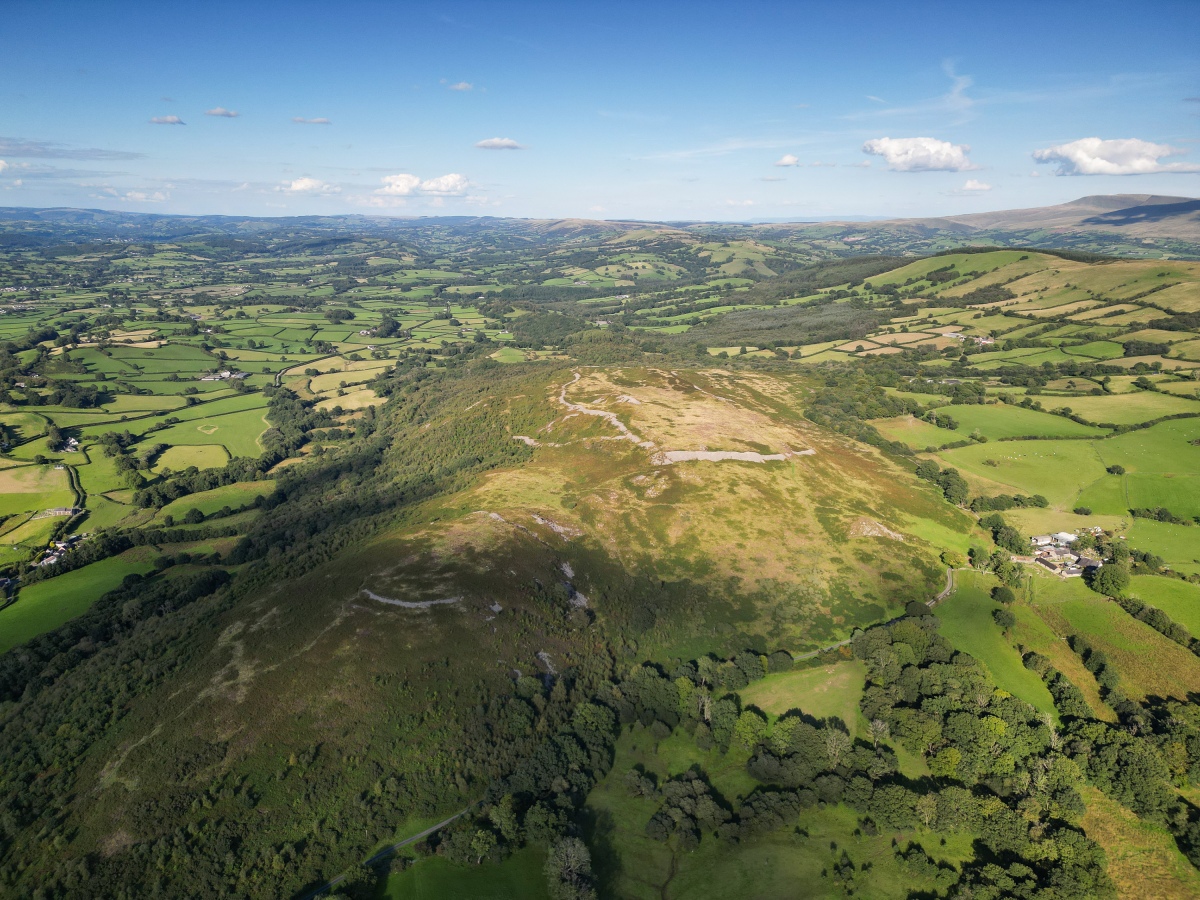[< Gallery Home | Latest Images | Top 100 | Submit Picture >]
277514 Pictures
|
<< Previous Picture | Next Picture >>
Description
Y Carn Goch is located in the east of the Bannau Brycheiniog (Brecon Beacons) and lies four miles east of Llandeilo on the southern side of the Towy valley. The name means 'red cairn' due to the colour of the fern covered slopes as it dies off in Autumn. It is commonly known as Carn Goch or Garn Coch. This is the site of one of the most impressive hill forts in all of Wales, in fact it is two forts in one, Y Gaer Fach (the small fort) and Y Gaer Fawr (the large fort) both seen in this view. It is Iron age fort with Bronze Age origins (cairn at the highest point in the large fort). What you see now was constructed between AD 47-78 .
In the Iron Age, (500 BC to the Roman period), the fortifications became more extensive and sophisticated with increased tribal unrest and warfare among the westward-moving Celts and the descendants of the Bronze Age 'Beaker' people. The Celts with their warrior cult and their iron weapons, chariots and mounted horsemen, were a vigorous and rapidly expanding group of peoples who brought their own distinctive culture to the British Isles.
The Garn Goch dominates the boundary between the Dematae and Silures tribal areas. The Silures occupied, at the time of the Roman invasion, the whole of South-Wales from the Severn to the Towy. The Dematae held domain over south-west Wales (west Carmarthenshire and Pembrokeshire). To the north of both areas the main, and possibly more numerous, tribes were Ordovices.
The Silures were the most aggressive tribe and gave the Roman invaders the most trouble to subdue. There is some evidence that the Dematae were willing to submit to the Roman yoke and ally themselves against their old enemies the Silures.
Soon after the Roman invasion in AD 43 and the Roman thrusts into Wales across the Severn in AD 47, Garn Goch was probably rebuilt and strengthened to meet any threat from the Towy Estuary and westwards. Also, from the Romans striking down from the north through the comparatively open countryside and easy going terrain of the Black Mountain.
We know the names of two Romans and one Celt who probably walked within these walls and they are:
Military Governors of Roman Britain:
Ostorius Scapula AD 47-52 who campaigned in south Wales against the Silures during this tenure.
Sextus Julius Frontinus AD 74-75 who finally subjugated the Silures.
The Celt:
Caractacus (son of Cunobellinus, British King) AD 41-51 who gallantly resisted the Roman invasion of AD 43 and was finally captured by Ostorius Scapula in AD 51. Caractacus was pardoned and honoured by Claudius in Rome.
Caractacus is the Roman form of the native Welsh name Caradog, a name still found in Wales today.
In the Iron Age, (500 BC to the Roman period), the fortifications became more extensive and sophisticated with increased tribal unrest and warfare among the westward-moving Celts and the descendants of the Bronze Age 'Beaker' people. The Celts with their warrior cult and their iron weapons, chariots and mounted horsemen, were a vigorous and rapidly expanding group of peoples who brought their own distinctive culture to the British Isles.
The Garn Goch dominates the boundary between the Dematae and Silures tribal areas. The Silures occupied, at the time of the Roman invasion, the whole of South-Wales from the Severn to the Towy. The Dematae held domain over south-west Wales (west Carmarthenshire and Pembrokeshire). To the north of both areas the main, and possibly more numerous, tribes were Ordovices.
The Silures were the most aggressive tribe and gave the Roman invaders the most trouble to subdue. There is some evidence that the Dematae were willing to submit to the Roman yoke and ally themselves against their old enemies the Silures.
Soon after the Roman invasion in AD 43 and the Roman thrusts into Wales across the Severn in AD 47, Garn Goch was probably rebuilt and strengthened to meet any threat from the Towy Estuary and westwards. Also, from the Romans striking down from the north through the comparatively open countryside and easy going terrain of the Black Mountain.
We know the names of two Romans and one Celt who probably walked within these walls and they are:
Military Governors of Roman Britain:
Ostorius Scapula AD 47-52 who campaigned in south Wales against the Silures during this tenure.
Sextus Julius Frontinus AD 74-75 who finally subjugated the Silures.
The Celt:
Caractacus (son of Cunobellinus, British King) AD 41-51 who gallantly resisted the Roman invasion of AD 43 and was finally captured by Ostorius Scapula in AD 51. Caractacus was pardoned and honoured by Claudius in Rome.
Caractacus is the Roman form of the native Welsh name Caradog, a name still found in Wales today.
No comments. Why don't you go ahead and post one!
To post comments first you must Register!

